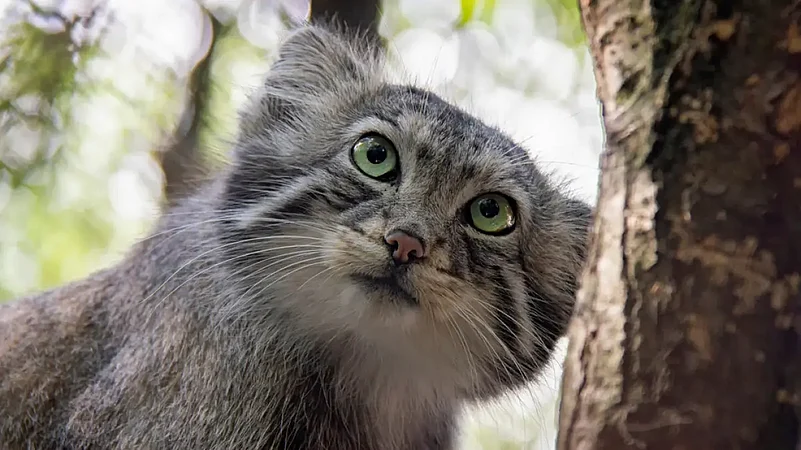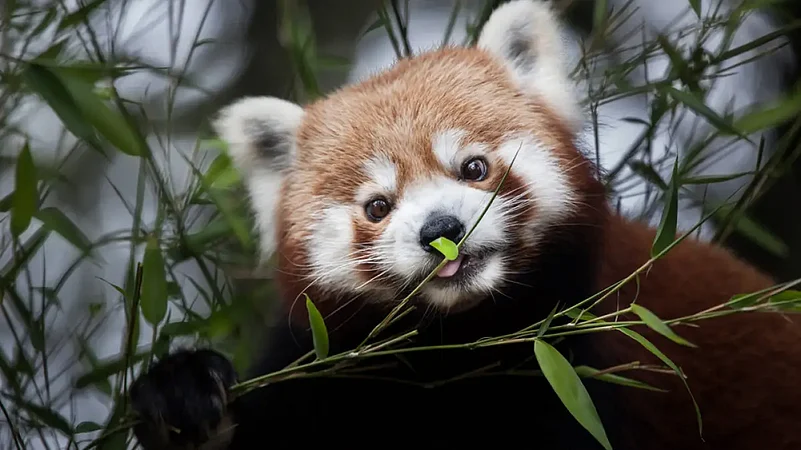Due to encroachments, and climate change, many of the species found in Sikkim are endangered or threatened. The lowland forests of Sikkim are home to Sikkim’s largest reptile Burmese python, house geckos, the Himalayan crestless porcupine, the Chinese pangolin, and barking deer.
Several species of birds can also be found here — the great pied hornbill locally called ‘hongraio’, chestnutbreasted partridge, the red junglefowl, and more. Subtropical regions are home to the red panda, red fox vulpes, the golden jackal, leopards, Asiatic black bear, palm civets, flying squirrels, wild boars, japalura lizards, cobras, kraits and mountain pit vipers. The gaur — one of India’s largest bovids — has been seen in Pangolakha Wildlife Sanctuary. Birdwatchers should head to Lake Khecheolpari in West Sikkim where species such as the critically endangered baer’s pochard, aythya baeri and vulnerable black-necked crane grus nigricollis have been spotted.
Sikkim’s temperate regions are home to the red panda, langur, yellow-throated marten, the Asiatic black bear, Himalayan goral, the golden cat, endangered wild dog, clouded leopard, and the fire-tailed sunbird. And its alpine forests shelter the endangered alpine musk deer, threatened Himalayan tahr, blue sheep, and bright-red blood pheasants. The cold deserts in north Sikkim are home to the kiang or Tibetan wild ass, Tibetan argali, snow leopards, Eurasian lynx, Tibetan wolf and others.

Besides being one of the primal adventure destinations in the country, Sikkim is also an ideal bird watching destination. It has more than 550 species of birds, some of which have been declared endangered. You will also find a rich diversity of butterflies too — about half the 1,400 butterfly species recorded in India are found here, including the magnificent, but endangered Kaiser-i-Hind, the Yellow Gorgon and the Bhutan Glory. You can spot most of them in the four sanctuaries in Sikkim and at the Khangchendzonga National Park.
Red Panda
This chestnut-coloured, tree-dwelling mammal with pointed ears and bushy tail is the state animal of Sikkim and can be found on the coat of arms of the Sikkim Forest Department. They can be found in the deciduous broad leaf and coniferous forests of the eastern Himalayas, but World Wildlife Fund (WWF) reports say that these forests are steadily being cleared for timber extraction, agricultural development and livestock grazing, and the species has been extensively hunted for its pelt—used in traditional hats and clothing across the border in China. Take a walk around Pangolakha Wildlife Sanctuary and Barsey Rhododendron Sanctuary to spot them.
Snow Leopard
Found in high altitude alpine and sub-alpine areas, this elusive animal has been captured on camera only a few times in northern and western Sikkim. But climate change and possibly vanishing food ecosystems has meant it is being seen in lower altitudes now. In January 2019, hidden cameras captured a snow leopard in the Pangolakha Wildlife Sanctuary in East Sikkim. About a year before that, a Bengal Tiger was spotted in the same area. It is a Schedule 1 animal and listed as ‘endangered’ by International Union for Conservation of Nature (IUCN).
Yak herders and local guides in the high mountain valleys of Lachen have also been helping in keeping track of

with the help of camera traps. As citizen scientists, they have also been documenting this animal after training with the WWF to establish the first baseline count for the (already low) local snow leopard population.
Wild Ungulates
The cold desert region of Sikkim—like the Tso Lhamo region—is home to wild ungulates such as the Tibetan argali, Tibetan gazelle, kiang, and bharal or blue sheep as well as the domesticated yak. Surveys have also shown the presence of the elusive Pallas’s cat. Incidentally, the bharal was also the focus of Peter Matthiessen’s 1973 expedition to Nepal documented by Matthiessen in the book, The Snow Leopard.
Blood Pheasant

This is the state bird of Sikkim. The name comes from the vivid red colouring on the feathers of the breast, throat and forehead of the males. Female birds are reddish brown, and in more uniform tones. They can be found in coniferous or mixed forests and scrub areas at the snowline. During summers, they move to higher elevations, and in winter, they go down to much lower altitudes.
Kaiser-e-Hind
The Emperor of India — that’s what this stunning butterfly is called. This rare species, coloured in bright yellows, shimmering greens, and subdued blacks, is found along the woods of Eastern Himalayas at medium and higher elevations from 6,000ft to 10,000ft. Look up to sot one as it flies at treetop level. If there’s strong morning sunlight, it may come down to perch on lower vegetation. One must visit Sikkim between the months of April and July to witness this gorgeous little creature.
Avifauna
Sikkim’s exceptional biodiverse landscape supports over 22 restricted-range bird species, including at least 19 species that are endemic to the region and bird species that are not found anywhere else in the world. Its unique position on the map means that, despite its small size, Sikkim, with over 550 species, has a birdlist that is almost as diverse as that of Bhutan or Nepal.
Due to the progressive conservation policies of the government that are supported by the highly benign Buddhist religious beliefs of locals, Sikkim has a very high percentage of its land under official protection as Protected Areas (PA) or Important Bird Areas (IBA). The state provides legal protection to critical bird habitats through a network of 22 IBAs and almost an equal number of PAs.
Khangchendzonga National Park

The largest wildlife reserve in Sikkim has the third highest peak in the world, the Khangchendzonga, straddling its western boundary and the vast Zemu glacier. It is home to the snow leopard, Himalayan black bear, Tibetan antelope, wild ass, barking deer, musk deer, flying squirrel and the red panda who live in blissful isolation amongst giant magnolias, rhododendrons and pine forests. A visit here comes highly recomended during your explorations of the state.
Maenam Wildlife Sanctuary
The temperate forest is home to the red panda, leopard, black eagle and civet cat amongst other animals and birds found in the region. The 3,263m high Maenam Peak also lies within the confines of the wildlife reserve.
Barsey Rhododendron Sanctuary
Tucked between the Khangchendzonga National Park to the north and Singalila National Park to the south, Barsey/ Varsey Rhododendron Sanctuary (10,000ft) in west Sikkim is known for its trekking routes, mountain vistas, flora and fauna. Depending on the weather, usually between March and May, the forest breaks into a profusion of rhododendron (locally known as guras) flowers. According to many trekkers, when the red variety of rhododendrons bloom together, they virtually set the forest on fire. If you are extremely lucky, you may catch a glimpse of a bear or even a rare red panda.
Fambong Lho Wildlife Sanctuary
This one hosts a large variety of birds and butterflies along with a population of leopards, red pandas, civet cats and the Himalayan black bear. The sanctuary is also home to a large number of wild orchids and rhododendrons. It’s a great place to see several species of laughing thrush including the redfaced liocichla Kyongnosla Alpine Sanctuary: This sanctuary is home to several endangered species like the red panda, musk deer, Himalayan black bear, serow (long haired goat) and some rare species of pheasants.
BIRDWATCHING SITES IN SIKKIM
In South and West Sikkim, Pelling/Pemayangtse and nearby villages have several interesting birding trails worth taking. Maenam Wildlife Sanctuary starts at about 200m and gradually rises to 3,000m at Maenam Top. This is a good site to look out for satyr tragopan, blood pheasants, rusty-bellied shortwing, among others. Khecheopalri Lake hosts many waterfowl besides being the wintering habitat of the black-necked crane.
In East Sikkim, Rumtek Gompa and Fambong Lho Wildlife Sanctuary are rich in birdlife with most forest species being seen here as well. Tsomgo/Changu Lake (3,800m) and Kyongnosla Alpine Sanctuary (3,300m) can be explored by hardy birdwatchers for high-altitude Himalayan species.
In North Sikkim places to visit include Yumthang, Lachung/Lachen, Chungthang and Shingba Rhododendron Sanctuary (2,900-4,300m).
For permits, check with the National Park and Wildlife Sanctuary Permit Issued by Forest Department at Gangtok.





















